अगस्त . 13, 2025 01:40 Back to list
Scaffolding Jacks: Durable Screw, U-Head, Swivel & Base Jacks
Understanding Scaffolding Jacks: Essential Components for Structural Integrity
In the dynamic world of construction and industrial maintenance, the stability and safety of scaffolding structures are paramount. At the heart of this stability lie scaffolding jacks, critical adjustable components designed to support and level scaffolding systems on uneven terrain or various base surfaces. These robust elements, often referred to as scaffold jacks or jack scaffolding, play an indispensable role in ensuring that a temporary work platform remains plumb and capable of safely bearing the required loads, including workers, materials, and equipment. The industry is currently witnessing a trend towards more advanced materials, precise manufacturing, and enhanced safety features, driven by stringent regulatory standards and the demand for greater operational efficiency across diverse sectors such as petrochemical, energy, shipbuilding, and infrastructure development. The proper selection and deployment of these components directly impact project timelines, safety records, and overall cost-effectiveness, making their technical specifications and reliability non-negotiable considerations for B2B decision-makers.
Modern construction projects, from high-rise buildings to complex industrial plants, increasingly rely on adaptable and resilient scaffolding solutions. This adaptability is largely facilitated by the innovative design and engineering of scaffolding jacks. Their ability to compensate for variances in ground levels ensures a stable foundation for the entire scaffold system, preventing shifts or collapses that could lead to catastrophic failures. Furthermore, the integration of specialized types like swivel jack scaffolding allows for angular adjustments, accommodating sloped surfaces with ease. As a result, the market for high-quality scaffolding jack base suppliers and manufacturers continues to grow, emphasizing the need for robust, durable, and standard-compliant products.
The Backbone of Support: Bass Jack & U-Head Jack
Two primary types of scaffolding jacks form the cornerstone of any adjustable scaffolding system: the Bass Jack (or scaffolding jack base) and the U-Head Jack (or scaffolding jack head). The Bass Jack, featuring a solid base plate, provides a stable foot for the vertical standards of the scaffold, distributing the load evenly over the ground or base surface. Its threaded shaft allows for precise height adjustments, critical for achieving perfect leveling on uneven terrain. This foundational component is vital for the initial setup and ensures the scaffold's upright integrity from the ground up, effectively transferring vertical loads into the ground.
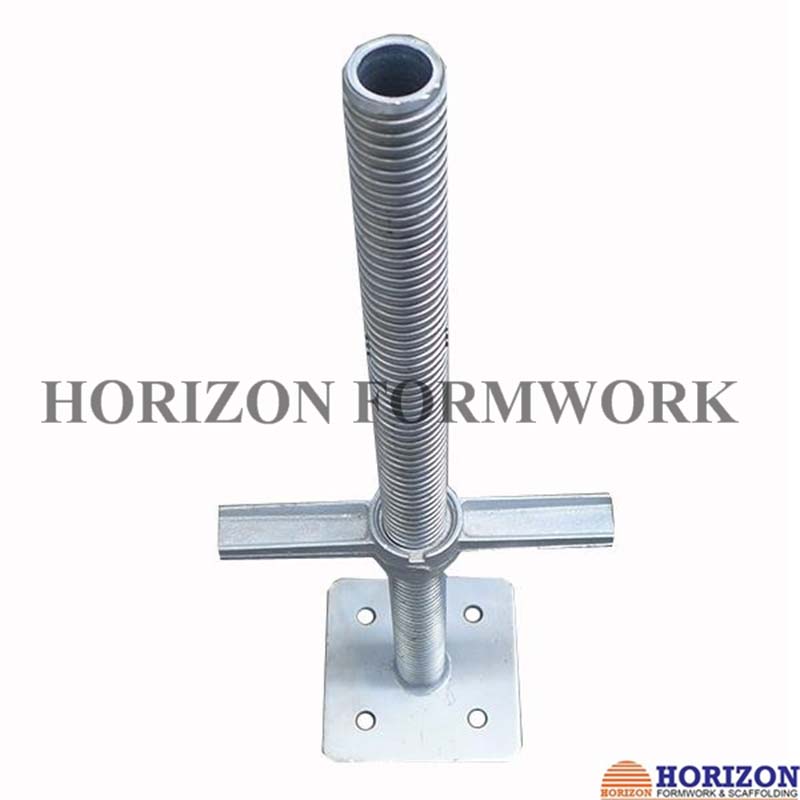
Conversely, the U-Head Jack is designed to support horizontal members of the scaffolding system, such as timber beams or steel joists, at the top of a vertical standard. Its distinctive "U" shape cradles these members securely, preventing lateral movement and ensuring a stable platform for subsequent levels or working surfaces. This type of scaffolding jack head is particularly beneficial when erecting support structures for formwork, temporary roofs, or heavy-duty propping applications where secure placement of horizontal elements is crucial. Both the Bass Jack and U-Head Jack are often variants of screw jack scaffolding, allowing for fine-tuned adjustments by rotating a threaded rod, demonstrating exceptional versatility and reliability in diverse construction environments.
Precision Engineering: The Manufacturing Process of Scaffolding Jacks
The production of high-quality scaffolding jacks is a meticulous process that combines advanced material science with precision engineering. It typically begins with the selection of high-grade steel, such as Q235 or Q345, chosen for its excellent tensile strength and durability. The manufacturing journey for a typical scaffolding jack involves several critical stages, ensuring each component meets rigorous safety and performance standards. This comprehensive process guarantees the longevity and reliability essential for demanding industrial and construction applications.
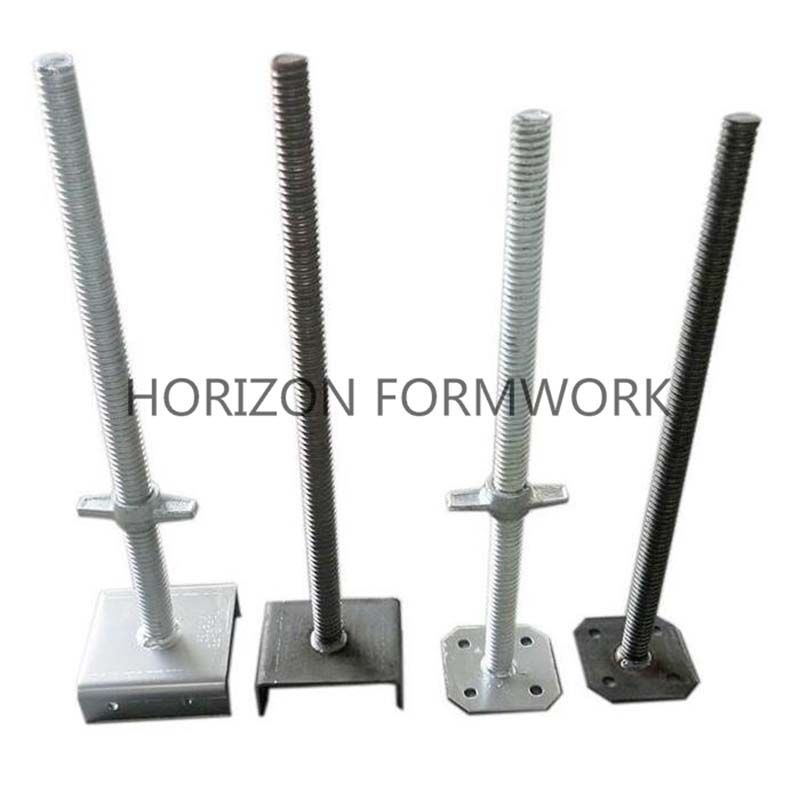
- Material Sourcing & Cutting: High-quality carbon steel tubes and plates are sourced, often complying with international standards. These materials are precisely cut to size using automated saws or plasma cutters.
- Threading: The crucial threaded section of the screw jack scaffolding shaft is formed either through roll threading, which cold-forms the thread and strengthens the material, or through CNC machining for precise, consistent pitch and depth.
- Welding & Assembly: Base plates, U-heads, and collar nuts are securely welded to the threaded rods. Automated robotic welding systems are frequently employed to ensure strong, consistent welds free from defects.
- Surface Treatment: To enhance corrosion resistance and extend service life, components undergo surface treatments. Hot-dip galvanization is preferred for superior protection against rust and harsh environments, ensuring the scaffolding jack base and head remain robust even in challenging conditions like those found in petrochemical or marine industries. Electro-galvanizing or painting are also common for less demanding applications.
- Quality Control & Testing: Each batch of scaffolding jacks undergoes stringent quality checks. This includes visual inspection, dimensional checks, thread gauge tests, and crucially, load testing to verify their capacity against standards like ISO 9001, ANSI/SSFI A10.8, or EN 12810. Non-destructive testing (NDT) methods like ultrasonic or magnetic particle inspection may also be used to detect internal flaws.
This rigorous process ensures a long service life and exceptional reliability, making these components suitable for critical applications in diverse industries such as petrochemical, metallurgy, energy, and water supply/drainage systems, where resistance to corrosion and high load-bearing capacity are essential for safety and operational continuity.
Technical Specifications & Performance Data for Scaffolding Jacks
Understanding the technical parameters of scaffolding jacks is crucial for ensuring safety, compliance, and optimal performance on any construction site. These specifications dictate a jack's load-bearing capacity, adaptability, and durability under various environmental conditions. Key parameters include material composition, ultimate load capacity, adjustment range, and surface treatment, all of which directly impact the operational efficiency and safety of a scaffold system. From hollow jack scaffolding designed for lighter loads and ease of handling, to solid jack scaffolding engineered for maximum strength, selecting the appropriate type based on these specifications is paramount.
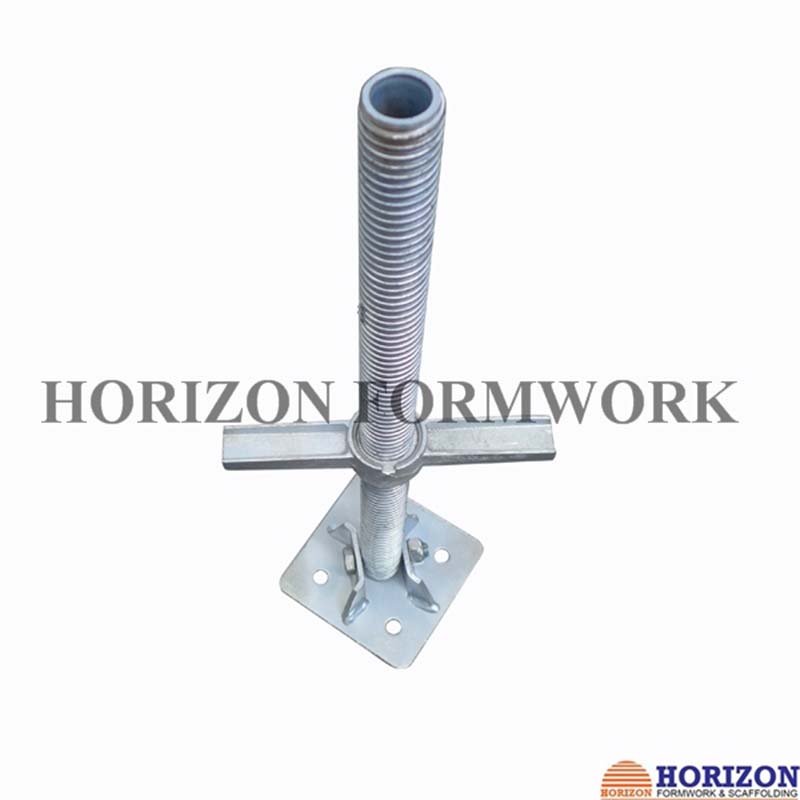
Typical Scaffolding Jack Parameters:
| Parameter | Common Range/Specification | Importance |
|---|---|---|
| Material Grade | Q235, Q345, ST37, S235JR (Steel) | Determines strength, durability, and resistance to deformation under load. |
| Load Capacity (kN) | Typical: 20-60 kN (approx. 2-6 metric tons) | Maximum safe vertical load the jack can support; critical for safety calculations. |
| Adjustment Range (mm) | 300mm to 750mm | The vertical distance the jack can be extended or retracted for leveling. |
| Outer Tube Diameter | 48.3mm, 60.3mm (standard scaffold tube sizes) | Ensures compatibility with standard scaffolding frameworks. |
| Thread Type | ACME, Trapezoidal, or Square thread | Influences ease of adjustment, load distribution, and self-locking capabilities. |
| Surface Treatment | Hot-dip Galvanized, Electro-Galvanized, Painted | Crucial for corrosion resistance and extended service life in harsh environments. |
| Compliance Standards | EN 12810, AS/NZS 1576, ANSI/SSFI A10.8 | Verifies adherence to national and international safety and quality regulations. |
Product Comparison: Bass Jack vs. U-Head Jack
| Feature | Bass Jack (Scaffolding Jack Base) | U-Head Jack (Scaffolding Jack Head) |
|---|---|---|
| Primary Function | Ground leveling and load distribution for vertical standards. | Support and secure horizontal timber or steel beams (e.g., for formwork). |
| Location in Scaffold | Bottom of vertical standards, on the ground or sole plates. | Top of vertical standards or shoring props. |
| Top/Bottom Feature | Solid base plate (square or round). | U-shaped fork. |
| Typical Applications | General scaffolding, access towers, shoring on uneven ground. | Supporting formwork beams, precast concrete elements, temporary roofing. |
| Material Variants | Often solid steel rod for durability (e.g., solid jack scaffolding). | Can be hollow or solid, often with a robust U-head welded on. |
Applications and Technical Advantages of Scaffolding Jacks
The versatility of scaffolding jacks makes them indispensable across a wide array of industries and applications, from standard access scaffolding to complex industrial support structures. Their primary technical advantage lies in their ability to provide precise vertical adjustment, crucial for ensuring the scaffold is perfectly level and stable, even on challenging or uneven terrain. This precision mitigates risks associated with unstable platforms, leading to safer working conditions and higher operational efficiency. Furthermore, specialized variants like u head jack scaffolding significantly simplify the integration of horizontal support elements, reducing assembly time and labor costs.
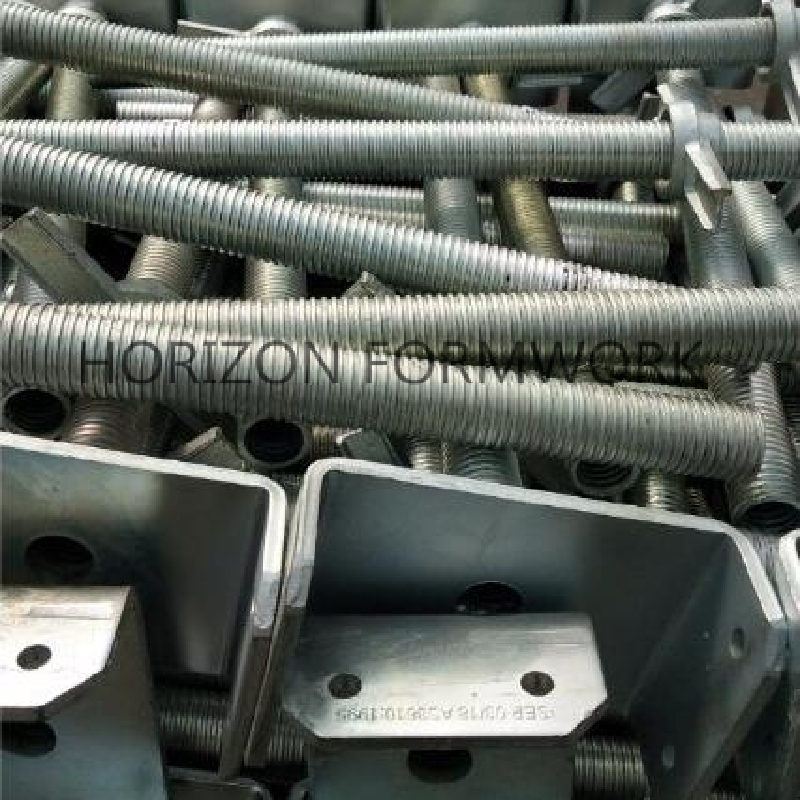
- Construction & Infrastructure: Essential for leveling scaffolds on rough ground, supporting temporary bridges, or providing stable bases for formwork during concrete pouring in both residential and commercial building projects.
- Petrochemical & Energy: In environments where corrosion resistance is critical, such as oil refineries or power plants, hot-dip galvanized scaffolding jacks offer superior durability and safety, minimizing maintenance and maximizing service life.
- Shipbuilding & Marine: Used in dry docks and shipyards to provide stable working platforms around large vessels, adapting to the unique contours and angles of ship hulls. Swivel jack scaffolding is particularly useful here for accommodating slopes.
- Metallurgy & Heavy Industry: Crucial for supporting heavy equipment or access platforms in foundries and steel mills, where robust solid jack scaffolding is preferred for its high load-bearing capabilities.
- Event & Entertainment: Employed in temporary structures for stages, lighting rigs, and seating, where quick setup and precise leveling are key for safety and aesthetics.
The inherent adjustability and robust construction of quality scaffolding jacks translate into significant benefits. They reduce manual labor in site preparation, accelerate scaffold erection, and ensure a consistently safe working environment. Their anti-corrosion properties, especially with advanced surface treatments, lead to extended product lifecycles and lower replacement costs, offering a compelling return on investment for businesses seeking reliable and sustainable scaffolding solutions.
Choosing the Right Partner: Manufacturer Comparison and Customization
Selecting a reliable supplier for scaffolding jacks is a strategic decision that impacts project safety, efficiency, and budget. When evaluating scaffolding jack base suppliers or scaffolding jack base manufacturers, B2B buyers must look beyond just price. Key considerations include the manufacturer's adherence to international quality standards (e.g., ISO 9001), their experience in the industry, the consistency of their product quality, and their capability for customization. A reputable scaffolding jack base manufacturer will typically offer comprehensive technical support, robust quality control, and a transparent supply chain.
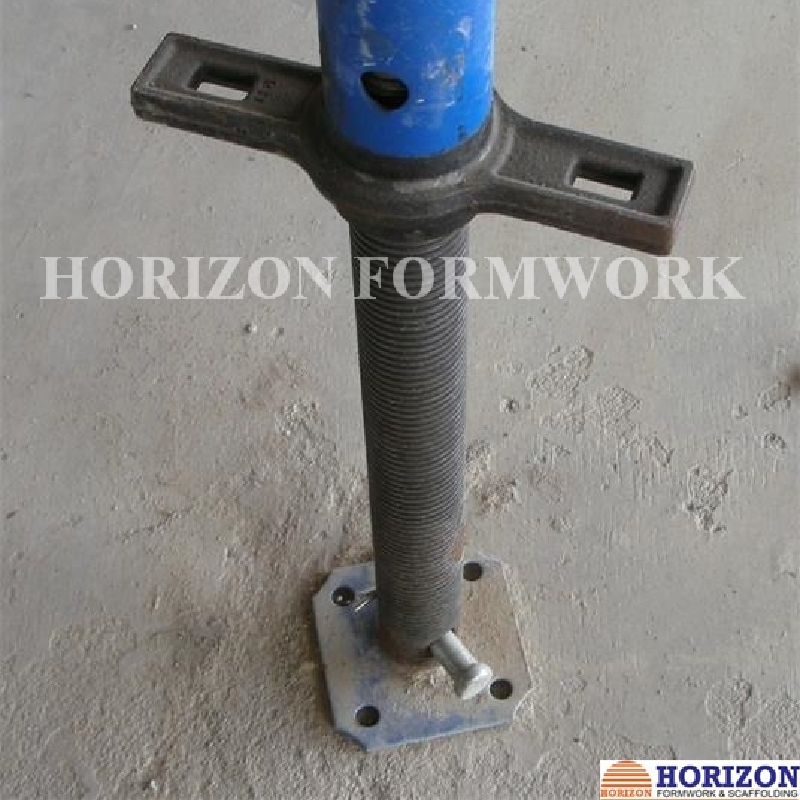
Furthermore, the ability to provide customized scaffolding jacks solutions is a significant advantage. While standard Bass Jacks and U-Head Jacks meet most requirements, certain projects, particularly those with unique structural challenges or highly specialized environments (e.g., highly corrosive industrial settings or extremely heavy load applications), may necessitate tailored designs. This could involve specific materials, non-standard dimensions, unique threading, or specialized surface treatments beyond typical galvanization. Collaborating with scaffolding jack base factories that possess in-house engineering and R&D capabilities ensures that these bespoke needs can be met without compromising safety or performance. A good partner acts as a solution provider, not just a product vendor, offering expertise to optimize the scaffolding system for specific project demands.
HorizonForm, as a seasoned scaffolding jack base manufacturer, prides itself on an extensive track record, backed by ISO certifications and a commitment to stringent quality control, ensuring that our scaffolding jacks are not only compliant with global standards but also exceed performance expectations. We offer both standard and custom solutions for Bass Jacks and U-Head Jacks, serving as a trusted partner for complex projects that demand precision and reliability.
Trust and Reliability: HorizonForm's Commitment to Quality and Support
Building trust in the B2B sector, particularly for critical components like scaffolding jacks, hinges on unwavering commitment to quality, transparent operational practices, and robust customer support. At HorizonForm, our extensive service history and numerous successful projects across diverse industries underscore our authoritative position as a leading scaffolding jack base supplier. Our products undergo rigorous testing, often exceeding industry benchmarks, to ensure they provide unparalleled safety and longevity. For instance, our Bass Jacks and U-Head Jacks are tested for ultimate load capacity under various conditions, with data consistently demonstrating their superior performance.
We maintain strict adherence to international standards such as ISO 9001 for quality management systems, ensuring every scaffolding jack leaving our facility meets global safety and performance criteria. Our commitment to trustworthiness extends to our logistics and customer relations. We provide clear, predictable delivery schedules, typically within 4-6 weeks for standard orders, with expedited options available upon request. Each product comes with a comprehensive warranty, affirming our confidence in its durability and performance. Our dedicated customer support team is available to assist with technical queries, order tracking, and any post-sales assistance, fostering long-term partnerships built on mutual reliability.
For a major infrastructure project in the Middle East, our custom-designed scaffolding jacks with enhanced corrosion resistance due to specialized hot-dip galvanization proved instrumental in stabilizing formwork for a large bridge structure. Despite extreme environmental conditions, the jacks performed flawlessly throughout the multi-year construction phase, reflecting our capabilities not just as a scaffolding jack base manufacturer, but as a comprehensive solution provider. This commitment to engineering excellence and client satisfaction is why clients repeatedly choose HorizonForm for their most demanding projects.
Frequently Asked Questions (FAQ) about Scaffolding Jacks
- Q1: What is the typical load capacity of a standard scaffolding jack?
- A1: The typical load capacity for a standard scaffolding jack ranges from 20 kN to 60 kN (approximately 2 to 6 metric tons), depending on its design, material, and compliance with specific safety standards. It's crucial to always refer to the manufacturer's specifications and local regulations for exact load ratings.
- Q2: How do scaffolding jacks ensure safety on uneven ground?
- A2: Scaffolding jacks, particularly the Bass Jack (or scaffolding jack base), feature a threaded rod and adjustable nut. This design allows for precise vertical leveling of the scaffold structure, compensating for uneven ground surfaces. By ensuring a plumb and stable base, they prevent structural stresses and potential collapses, enhancing overall site safety.
- Q3: What's the difference between hollow jack scaffolding and solid jack scaffolding?
- A3: The primary difference lies in the construction of the threaded bar. Hollow jack scaffolding uses a hollow tube for the threaded shaft, making it lighter and generally suitable for lighter-duty applications. Solid jack scaffolding, conversely, utilizes a solid steel bar, providing significantly higher load-bearing capacity and durability, making it ideal for heavy-duty shoring and support systems.
- Q4: What surface treatments are available for scaffolding jacks, and why are they important?
- A4: Common surface treatments include hot-dip galvanization, electro-galvanization, and painting. Hot-dip galvanization offers superior corrosion resistance, crucial for extending the service life of scaffolding jacks in harsh outdoor or corrosive industrial environments, reducing rust and maintenance needs. Electro-galvanization and painting provide more basic protection for less demanding conditions.
- Q5: Can scaffolding jacks be customized?
- A5: Yes, many reputable scaffolding jack base manufacturers and scaffolding jack base suppliers offer customization options. This can include specific lengths, unique base plate dimensions, specialized U-head designs (e.g., for u head jack scaffolding), or different material grades and surface treatments to meet the unique requirements of a particular project or challenging environment.
Conclusion & References
The humble scaffolding jack, in its various forms like the Bass Jack and U-Head Jack, stands as a testament to precision engineering and its critical role in modern construction safety and efficiency. As foundational components of any scaffold system, these adjustable elements ensure stability, provide precise leveling, and adapt to diverse site conditions. For B2B stakeholders, understanding their manufacturing processes, technical specifications, and diverse applications is key to making informed decisions that enhance project safety, reduce operational costs, and optimize overall structural integrity. Partnering with experienced scaffolding jack base factories committed to quality and innovation ensures that your projects are built on the most reliable foundations.
References:
- Construction Industry Institute. (2020). Best Practices for Scaffolding Safety and Design.
- Occupational Safety and Health Administration (OSHA). (2019). Scaffolding Standards for Construction. 29 CFR 1926.451.
- European Committee for Standardization (CEN). (2016). EN 12810: Facade scaffolds made of prefabricated components.
- Standards Australia/New Zealand. (2015). AS/NZS 1576: Scaffolding.
- American National Standards Institute (ANSI) and Scaffold & Access Industry Association (SAIA). (2018). ANSI/SSFI A10.8-2018: Scaffolding Safety Requirements.
This is the last article
-
Scaffolding Jacks: Durable Screw, U-Head, Swivel & Base Jacks
NewsAug.13,2025
-
Reliable China Single Sided Wall Formwork Manufacturer
NewsAug.12,2025
-
Formwork Wing Nut | Quality Tie Rod & Water Stop Supplier
NewsAug.11,2025
-
Durable Steel Prop with Tripod for Stable Support
NewsAug.10,2025
-
OEM Column Formwork: Custom, Circular, Curved & Adjustable
NewsAug.09,2025
-
Custom OEM Column Formwork | Versatile & Efficient Solutions
NewsAug.08,2025